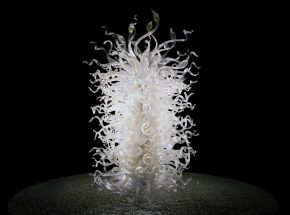

Born in Camaguey, Cuba in 1955, DEMI is one of the most critically acclaimed Cuban-American artists working in the United States. She depicts a vibrant and intimate universe centered upon children, but hers is neither a sugar-coated nor an innocent vision. DEMI paints luminous and powerful children whose lives have been exposed to the vagaries of the adult world. DEMI has first-hand knowledge of the plight of children whose fates are altered by devastating events. Her father was executed in Castro’s Cuba when DEMI was still a child. DEMI was sent to Puerto Rico to live with relatives at the age of six. She finally joined her family in America in 1971, and they eventually settled in Miami where she graduated from Miami-Dade Community College. DEMI is a sobriquet to indicate her life was cut in half by exile, and she emphasizes individuality and ambiguity by avoiding the use of a last name. “I belong to a forgotten group: children of those executed in Cuba for political reasons,” the artist states. “Sons and daughters still too young of age to understand why we were confronted with death, separation and loneliness. My paintings blossom from the inner depths of those childhood memories. “In 1978 at a gallery opening, DEMI met Arturo Rodriguez, a gifted Cuban-American painter, who was to become her partner in life and in art. Rodriguez was DEMI’s first teacher, as well as a tremendous intellectual and cultural influence. The two were married in 1984 and continue to live and work in Miami. DEMI deliberately employs a naïve style and paints mainly children. Her subjects are denuded and androgynous, preternaturally mature and far from ingenuous, reflecting their precocious experiences. Although rooted in her personal history, these subjects are fanciful and universal, with powerful social and political overtones. DEMI has created almost a new medium in her manipulation of acrylic paint because she is able to paint with acrylic in the translucent layering that is the property of oil paint. In stretching her medium in defiance of the limitations of accepted practice and expectation, DEMI has broken through pictorial boundaries that would bind any other artist. These paintings are exceptional in the imagery and content and them, but it is their technique that makes them significant artistic statements for those who value the manner in which an artist can reform our sense of materials. For DEMI, the meticulous layers of paint represent layers of memory and meaning. DEMI’s work is highly acclaimed and has been widely exhibited and published. She has been represented in group and solo exhibitions for more than 25 years, and often uses her work as a forum to raise awareness for children’s rights. Since 1998 the Smithsonian’s Archives of American Art has been collecting DEMI’s primary records (correspondence, notebooks, drawings, photographs, catalogues). In 2009, DEMI was personally invited by the U.S. Ambassador to the Holy See, Miguel Diaz, to display one of her works in the US Embassy residence in the Vatican City. The painting, Two Artists and Their Children of Their Imagination, will be on view for two and one half years as part of the prestigious ART IN EMBASSIES program. DEMI’s works are featured in many public and private collections worldwide and have been widely exhibited in Galleries and Museums, including Switzerland, France, Panama, Puerto Rico and the United States.
Website
http://www.demiart.net
